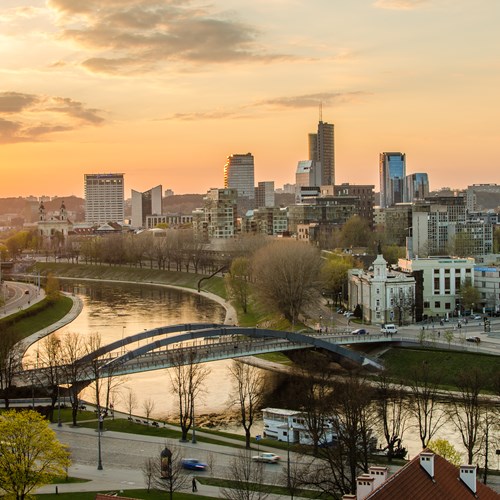
Vilnius, Lithuania
Vilnius, the capital of Lithuania, is one of the most attractive cities in Eastern Europe. It draws attention, not only because of its unique architectural character, but also because of its cultural events and attractions. During the first ten years of Lithuanian independence, the city began to draw in visitors. The number of tourists has consistently increased during those ten years and tourist infrastructure and services developed greatly at the same time.
Population:
588,412 (2021)
Currency:
Euro (EUR) €1 = 100 cents
Emergency Numbers:
Emergency: 112
Opening Hours:
Business hours are from Mon–Fri between 8am–5pm. Shops are normally open from 10am–6/7pm on weekdays and until 3/4pm on Saturdays.
Newspapers:
Lietuvos rytas
Respublika
Verslo žinios
Vilniaus diena
The Baltic News
The City

Vilnius is a UNESCO World Heritage Site, and it is not hard to see why with all the wonderful historic sights found here. The city’s extraordinary appearance of historic continuity is all the more amazing when you consider its turbulent history. Vilnius is now back where it rightly belongs, at the heart of Europe, and this most quintessentially European of cities has quickly gained a reputation as being a charming, delightful and, it has to be said, magical place.
It is no wonder that Vilnius has become such a popular tourist destination in recent years for the simple reason that few people can resist its magical charms. The city is large enough to explore, but small enough not to get permanently lost in, Vilnius is an architectural dream come true, a city soaked in atmosphere, and alive with history.
Despite its reputation as a Baroque city, Vilnius is rich in other architectural forms. There are some stunning examples of classicism, eclecticism, brick gothic and art nouveau in the city centre, especially along the showcase Gedimino Avenue. The city abounds with quirky architectural flourishes, from mysterious masks to mischievous gargoyles. Quite simply, you just cannot take your eyes off the place.
Most of the buildings in Vilnius date from the periods immediately after the great fires of 1610, 1737, 1748 and 1749, when the city’s wooden buildings were done away with. Amazingly, however, the Old Town’s street structure is virtually unchanged since medieval times.
The best way to see Vilnius is on foot (just follow the cobblestone road). The city is also a dream for cyclists with clearly-marked cycle lanes covering virtually the entire city centre, and bringing all the city’s sights within easy reach.
There is, of course, much more to Vilnius than the Old Town. The city centre is filled with beautiful parks, and majestic buildings standing proudly atop steep, hilly streets. It is also a delight to walk along the banks of the river Neris as it serenely snakes its way through the city centre. The riverside path offers spectacular views of the Old Town on one side, and the imposing skyscrapers of the New District on the other.
Do & See

No trip to Vilnius is complete without a visit to the self-declared Republic of Užupis, just across the sparkling river Vilnia, and behind the spectacular red Gothic façade of St. Anne’s Church. Just be sure not to miss the prominently displayed constitution (it is in Lithuanian, French and English) which states, among other things, that: “Every dog has the right to be a dog.”
Other places of special interest include Vilnius University, the Hill of Three Crosses, the Gates of Dawn, the Presidential Palace, the Town Hall, Ponar Memorial, Kalvariijų market, not to mention countless other museums, galleries, churches and statues. Just one thing is certain when it comes to Vilnius: one visit is never enough.
Dining

Over the centuries, Lithuanians have created a unique array of dishes, influenced by the culture of various nationalities. A distinctive trait of Lithuanian cuisine is the preponderance of potato dishes. The most impressive of these are the cepelinai ("zeppelins"), large boiled potato dumplings made from grated raw potato with fillings of minced meat or cottage cheese. Other traditional potato dishes are various types of kugelis (potato loaf) and potato salad, potato pancakes made from grated raw potato or boiled potato (sometimes with meat filling), and small potato dumplings with mushroom or berry filling. Perhaps the most exotic Lithuanian dish is vėdarai or potato sausages – pork intestines stuffed with grated raw potato, baked in a wood stove or electric oven.
Soup is very popular in Lithuania. One of the most interesting Lithuanian soups is šaltibarščiai (cold beetroot soup), which is made from beets/beetroot, kefir (a fermented milk product), greens, and boiled eggs. This dish is most popular when served on a hot summer day.
Vilnius has a staggering array of outstanding places to dine, offering the best in French, Italian, Chinese, Japanese, Polish, Mexican, Indian, Russian, German, and Kosher food, as well as many cutting-edge international restaurants. And of course, no visit to Vilnius could be complete without experiencing one of the city’s many welcoming Lithuanian restaurants.
Bars & Nightlife

Nightlife in Vilnius caters to every budget and taste. You can enjoy a beer at one of the many pubs here or hit one of the clubs. Make sure you dress well as face control is very much enforced.

